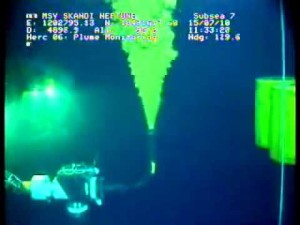It is our policy to only focus on ocean noise pollution issues to keep our message clear. But a good number of people have requested information on the ongoing state of affairs in the Gulf on Mexico. Oil spills are not my field, but having recently returned from the leading conference on offshore extraction technologies, I may be able to shed some light on the situation.
While I intentionally avoid hyperbole, this particular petroleum reservoir eruption caused by exploratory drilling threatens to become the largest single-event environmental disaster in human history (if you exclude US energy and climate policy, which got us into this mess in the first place).
Reports on how extensive the problem is are continuously underestimated by the liable parties. Even the “revisions” are likely to be grossly under-reported. BP maintains that the “leak” is yielding 5000 barrels per day – at 42 US Gallons per barrel, this amounts to 210,000 gallons per day.
To get an idea of how much oil this is: a typical residential swimming pool holds about 50,000 gallons, so the 210,000 gallon estimate is equivalent to four residential swimming pools of oil each day.
In the words of John Amos of SkyTruth “Are we really being asked to believe that the spill-response capability of one of the world’s biggest oil companies AND the United States Coast Guard has been totally overwhelmed by a spill of just 210,000 gallons per day?”
Oil and water do not mix, causing the oil to spread thinly over water. Currently the size of the surface oil is ~5,000 sq. miles, or in “square” terms, 70 miles x 70 miles. There are unconfirmed reports that there are also large deep water oil blooms that may be a consequence of sub-surface application of dispersants.
The difficulty in stemming the eruption is due to the extreme environment. The drilling site is 5000’ deep. The operating pressures at that depth are about 150 atmospheres, or 2000 lb.in2. This generally precludes mitigation work by human divers, so all work must be done remotely buy remotely operated vehicles (ROV’s).
While ROV technology is impressive, the manipulators are designed to handle regular objects like shut-off valves, cables, and bolts, not crushed and damaged hardware. For the operators, manipulating around this mess must be akin to working with 5000’ long chop sticks.
And then there is the physics of the eruption itself. Oil reservoirs are deposits of Miocene through Pleistocene era terrestrial and marine life (24 – 1 million years ago). Through tectonic action these deposits have subducted to depths of up to 20,000 ft (or more) below the seabed, under enormous pressures. Gulf of Mexico deposits are commonly 10,000 – 20,000 lb.in2. This would be the pressure at the well head (and the “leak”). This is not something you can just put a cork in. This is why the blocking strategies involve heavy muds, cement, and lots of small objects, in hopes that something will get “stuck” before it blows out.
Perhaps if the eruption were just liquid oil it might be easier to handle, but it is mixed in with gas and sand – all under enormous pressure. (By comparison, an industrial sand blaster may operate at 300 lb.in2.)
As investigators look back they are finding that a number of procedures were omitted or bypassed. While this blow-out is not “unprecedented” as claimed by BP, (the Timor Sea spill last fall was an uncannily similar scenario) hubris on the part of the operators led us up to where we are.
Early on in this event Alaska Oil darling Senator Lisa Murkowski stated that this is only one incident in thousands of successful wells, indicating that the technologies are inherently safe.
It is also inherently safe to drive around at 200 mph… until you hit something.

